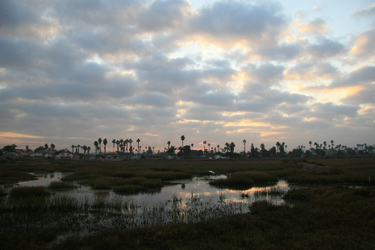Human Impacts on Salt Marshes
 Wetland
Wetland 
edited by Brian R. Silliman, Edwin D. Grosholz, and Mark D. Bertness
University of California Press, 2009, 432pp
Reviewed by Rob Goldstein
If you walk along a North American tidal wetland you can lose yourself in the sea of green cord grass set against the blue water or the song of marsh birds amidst the stillness. Yet, within this beauty, if you look, you can see the widespread human impacts - the exotic species invasions, altered hydrology, encroaching development - that have transformed the salt marsh, threatening its rich biological diversity and valuable ecosystem services.
 Tijuana Slough NWR. Photo credit, John J. Mosesso.In the United States where a large percentage of historic tidal wetlands have either been lost or substantially degraded, state and federal laws have forced the hand of government and business to address these human impacts. Today thousands of researchers, planners, and resource managers along with a huge consulting industry are working to solve these pressing, problems.
Tijuana Slough NWR. Photo credit, John J. Mosesso.In the United States where a large percentage of historic tidal wetlands have either been lost or substantially degraded, state and federal laws have forced the hand of government and business to address these human impacts. Today thousands of researchers, planners, and resource managers along with a huge consulting industry are working to solve these pressing, problems.
It's within this context, that the book Human Impacts on Salt Marshes establishes itself as a major contribution to the science and practice of North American tidal wetland conservation. The book presents an edited collection of 18 chapters written by leading wetland scientists, each exploring a particular impact or issue from a regional perspective. Most chapters conduct a thorough academic review to explore the topics in great depth. The chapters usually conclude with recommendations for future research and management action.The book is unique in that it brings together these regional findings to develop a continent-wide perspective.
A scientific review of the major human impacts and their ecological consequences...
The book begins with four chapters on exotic species. Three of these chapters focus on just invasive Phragmites and Spartina - species that are causing problems in tidal marshes around North America. These chapters go into such detail summarizing our knowledge about these invasions and their ecological consequences that they almost rise to the level of a desktop reference for the researchers and professionals working directly on these issues. In the fourth chapter, James Byers looks at the invasive animals of the Salt Marsh - species that have largely fallen under under the radar of many people.
The second section of this book explores the problem of overgrazing of marsh plants from animals that have had population explosions as a result of human influence. The findings in this section challenge the long held notion in salt marsh ecology that top-down factors (i.e. grazing) don't have a major influence in structuring plant communities as opposed to bottom-up factors. For example, Hugh Henry and Robert Jefferies review the case of the snow geese population explosion as a result of food from agricultural fields that has led to overgrazing of Arctic costal marsh vegetation, denuding the soil surface, and altering plant community structure.
The third group of chapters in the book is more of a catch-all section that looks at the remaining major impacts on the marsh - hydrological modification (specifically tidal restrictions and mosquito ditches), costal development, global warming, and elevated CO2 levels. The chapters on hydrologic modification and costal development explore our knowledge about these issues through the lens of regional examples in New England but the lessons are generalizable to the larger North American setting.
The fourth section of the book looks at the duel concepts of loss and conservation. Two chapters in this section focus on the case of marsh die-off which has been occurring along the Eastern and Southeastern coasts. The phenomenon is similar in nature to global amphibian and honeybee die-off in that many causes have been implicated but no single factor seems to be orchestrating what's happening - at lease none that we know of. The final section of the book gives an international perspective by providing a broader level review of the state of salt marsh ecosystems in Europe, South America, Australia, and New Zealand.
One of the goals (and challenges) of editing a book like this is to take what is essentially a compilation of academic research papers - each with its own story, approach, and writing style - and integrate that into a coherent, consistent narrative. I think through much of the book the editors of Human Impacts on Salt Marshes largely achieve that goal. One critique I have is that I think they could have applied a heavier editorial hand to a couple of the chapters to help them gel better with the focus of the rest of the book. Otherwise this is an excellent compilation of scientific review of the human impacts on North American salt marshes.
The most obvious audience for Human Impacts on Salt Marshes is the research and professional community who work with tidal wetlands on a daily basis. However, I also think that those with a strong interest in salt marsh conservation but perhaps not as strong a background in wetland ecology (e.g. planners, grant-makers, enthusiasts) may want to think about checking this book out. I say that with a caveat. This is definitely an academic read that's written with academics in mind. Terminology isn't explained, and reading some of this book will likely require having Wikipedia handy. Nonetheless, I think it's worth the investment.




Reader Comments